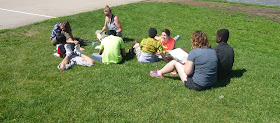 |
| Razor wire - the ultimate target hardener |
When the desert traveler dying from thirst sees the mirage of an oasis he diverts toward what he mistakenly thinks is his salvation. He does so, not because it is real, but because it is all he knows and because he is desperate.
This is what happened when shop-owners in London installed spikes to deter sleeping homeless people. The global backlash became an embarrassing public relations nightmare far worse than homeless people looking for a bed. Clearly, target hardening was a mirage that backfired.
Target hardening remains a mirage because we have very little research about its impact on community-building or on the perception of the public. Target hardening definitely conveys a message. What message does it convey about buildings, benches, urban parks and residential property? Does it drive people away for fear of crime? Is that message helpful for building local pride in our future communities?
Then in the early 1980s Ronald Clarke adopted target hardening as a component of situational crime prevention and that is where it has resided ever since.
Historically target hardening has been around a very long time. Some instructors like to equate medieval forts as examples of target hardening, but stretching a metaphor to antiquity does a disservice to contemporary democracies where human rights bind modern societies together.
PERSISTING IN THE LEXICON
Still, target hardening persists in the security lexicon because at times it works very well. I use it when other options don’t work such as high risk public housing prior to community-building programs. Regrettably, research on the topic is thin. Most target hardening research obsesses on common property crimes such as burglary, vandalism and thefts and to a lesser extent, robbery.
There is scant research on crimes against persons such as homicides, shootings or gang related violence, and what does exist is spotty. Luckily some research on target hardening still shows up in the property crime literature.





